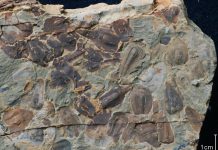
A team of paleontologists has unearthed a fossil of a gigantic flying reptile from the Jurassic period in Oxfordshire, UK.
This pterosaur, estimated to have a wingspan of over three meters, is one of the largest ever found from that era.
The fossil was discovered in a gravel pit near Abingdon-on-Thames, Oxfordshire. It includes part of the pterosaur’s wing bone, which was broken into three pieces but still well-preserved.
Experts from the universities of Portsmouth and Leicester have published their findings in the Proceedings of the Geologists’ Association.
The fossil was scanned and identified as belonging to an adult ctenochasmatoid, a group of pterosaurs known for their long, slender wings, long jaws, and fine bristle-like teeth. It is now housed in the Etches Collection in Kimmeridge, Dorset.
Professor David Martill from the University of Portsmouth said, “When the bone was discovered, its size was remarkable. We conducted a numerical analysis and estimated a maximum wingspan of 3.75 meters. Although this would be small for a Cretaceous pterosaur, it’s absolutely huge for a Jurassic one!”
He added, “This fossil is particularly special because it is one of the first records of this type of pterosaur from the Jurassic period in the United Kingdom.”
Pterosaurs from the Triassic and Jurassic periods typically had wingspans between one and a half and two meters, making them generally smaller than their later relatives from the Cretaceous period, which could have wingspans of up to 10 meters. However, this new discovery suggests that some Jurassic pterosaurs could grow much larger.
Professor Martill added, “This specimen is now one of the largest known pterosaurs from the Jurassic period worldwide, surpassed only by a specimen in Switzerland with an estimated wingspan of up to five meters.”
The fossil was discovered by geologist Dr. James Etienne while searching for fossil marine reptiles in June 2022. The Late Jurassic Kimmeridge Clay Formation was temporarily exposed in the floor of a quarry, revealing a number of specimens, including bones from ichthyosaurs and plesiosaurs, as well as other ancient sea creatures like ammonites, bivalves, marine crocodiles, and sharks.
Dr. Dave Unwin from the University of Leicester said, “Abfab, our nickname for the Abingdon pterosaur, shows that pterodactyloids, advanced pterosaurs that completely dominated the Cretaceous, achieved spectacularly large sizes almost immediately after they first appeared in the Middle Jurassic. This was right about the time when the dinosaurian ancestors of birds were taking to the air.”
The discovery of this gigantic Jurassic pterosaur provides new insights into the evolution and size range of these fascinating flying reptiles. It highlights the incredible diversity and adaptability of pterosaurs, even in the earlier periods of their existence.
The fossil will continue to be studied to uncover more details about the life and environment of these ancient giants.



